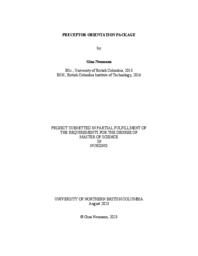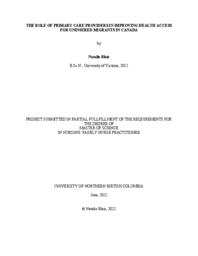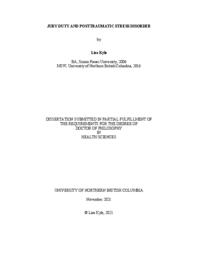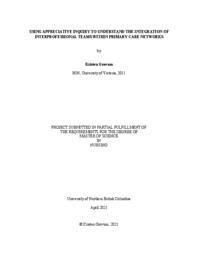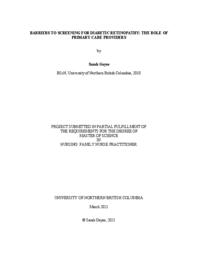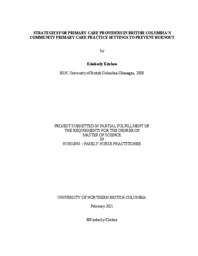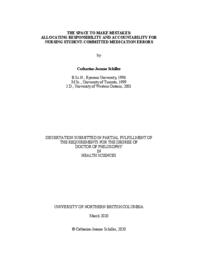Schiller, Catharine-Joanne
Person Preferred Name
Catharine-Joanne Schiller
Related Works
Content type
Digital Document
Description / Synopsis
The purpose of this project was to create an evidence-informed preceptor orientation package that would help nursing preceptors understand the essential components necessary to prepare for the preceptor role of BSN students in their final practicum in Level 3 Small Community Hospitals (21-100 beds) within the Interior Health Authority (IHA) in British Columbia. It was done in collaboration with IHA to fill a gap in preceptor education for registered nurses working with final practicum BSN students. A literature review identified key evidence-based nursing preceptor education concepts, which were integrated into a preceptor orientation package. The preceptor orientation package includes learning objectives and resources related to the role and responsibilities of the preceptor, goal-oriented preceptorship and learning styles, guiding a reflective discussion and feedback, creating a safe and supportive learning environment, and the preceptor’s motivation. The package's evaluation and implementation are explored, and the author's critical reflection concludes the paper.
Origin Information
Content type
Digital Document
Description / Synopsis
The purpose of this capstone project was to explore the question: How can primary care providers improve health access for uninsured migrants in Canada? An integrative literature review was conducted, followed by a comparison and analysis of the available literature. Much of the existing literature discusses the barriers that uninsured migrants face in Canada. There was very little research specifically directed towards primary care providers who work with uninsured migrants in Canada, and even fewer recommendations of tangible ways for primary care providers to improve health access for this vulnerable community. There were many limitations to researching the uninsured migrant community and because many of the health barriers uninsured migrants face are systemic and intersect with immigration, federal, and provincial legislation, many recommendations that exist in the literature would be considered outside the scope of a primary care provider. The project concludes with recommendations translated from the literature for primary care providers and provides suggestions for future research.
Origin Information
Content type
Digital Document
Description / Synopsis
Point-of-care ultrasonography (POCUS) is the process of operating a compact ultrasound machine at a patient’s location and immediately integrating the images generated into patient care. POCUS can help nurse practitioners (NPs) make more accurate diagnoses, facilitate safer procedures, and bridge health care access gaps in resource-limited settings such as primary care; however, it is widely agreed that POCUS is operator-dependent and that appropriate education is required to competently operate the device. This integrative review sought to determine what education NPs need to competently operate POCUS in primary care and it was found that there is no data specific to NPs; much of the available information is instead within the medical literature. Given the numerous benefits of POCUS for improving patient care and health care systems efficiency, NPs must urgently determine their POCUS education needs as they have ethical and legal obligations, in addition to a professional responsibility to ensure safe, high-quality patient care.
Origin Information
Content type
Digital Document
Description / Synopsis
Research on jurors and juror symptomatology has been conducted for many years; however, existing research has primarily been completed in the United States. What little research was conducted in Canada is now several years ago. Further, there is sufficient anecdotal evidence to suggest PTSD can and does occur as a result of serving jury duty. As such, this research sought to explore the relationship between jury duty participation and PTSD symptomology, as described by participants. This research is qualitative and involved two stages. First, participants (n=14) were asked to complete an online demographic survey that included a self-report measure for PTSD, the PCL-5. Second, participants (n=12) were invited to complete a one-two hour interview. Findings from the interviews were analyzed via thematic analysis. This research found three participants who met the criteria for probable PTSD (when using a cut-off score of 32). Overall, jurors in Canada echo previous research that states sources of symptoms relate to viewing disturbing images, deliberations, sequestering, and fear of making a mistake. New insight indicates fear associated with retaliation may be a major contributing factor for symptomology. Further, jurors whose life experiences relate to the trial type may be a contributing factor for symptomology. Policy and practice recommendations include improving information for jurors before they begin their service and providing more consistent follow-up support for jurors. Research should continue to explore the relationship between jurors and symptomology.
Origin Information
Content type
Digital Document
Description / Synopsis
Over the past fifteen years, primary care networks have been established across Canada; spaces whereby people can access a first point of contact with healthcare professionals focused on chronic disease management, health maintenance, and prevention. British Columbia has recently launched a model of primary care networks and interprofessional teams in response to a current health system challenged with demands related to an aging population and increased prevalence of chronic disease and disability. Using appreciative inquiry for understanding organizational social system change, information was gathered to explore the strengths and directional change needed as shared by primary care providers and case managers working in a Vancouver Island health authority primary care network. The purpose of the project was to understand how these providers could work more effectively within integrated interprofessional teams. Actions focused on the process of facilitating connection, communication, relationship, collaboration and autonomy within these networks are explicated.
Origin Information
Content type
Digital Document
Description / Synopsis
Diabetes is a serious health concern that affects millions of people world-wide. The comorbidities and complications of diabetes are complex and require awareness within the healthcare system. Diabetic retinopathy affects a significant number of patients living with diabetes. Early detection through screening is recognized as the standard of care, in order to assess and monitor for diabetic retinopathy progression. Unfortunately, screening services are not always accessed, especially within the suggested time frames and frequencies. Currently there is limited data regarding the barriers that exist for individuals to access these crucial screening services. An integrative literature review approach was conducted to answer the research question: What strategies can nurse practitioners in the primary care setting use to promote screening for people living with diabetes to reduce their risk and progression to blindness from diabetic retinopathy? Four themes emerged from the findings which provided insight into determinants that affect diabetic retinopathy screening adherence: structural barriers to care, socioeconomic conditions, emotional barriers to accessing healthcare, and knowledge deficits. Discussion of three recommendations for primary care practice focus on: reassessing screening methods and intervals, activity sharing, and providing education. Implications for future research to enhance patient care are outlined.
Origin Information
Content type
Digital Document
Description / Synopsis
Primary care providers (PCPs) suffer from high rates of burnout. Burnout is the result of chronic workplace stress. Burnout can significantly impact the PCP’s personal and professional life and can lead to devastating consequences. Literature often addresses organization level strategies to improve burnout rates but there is a dearth of literature focusing specifically on PCP-directed strategies to prevent burnout. Using Whittemore and Knafl’s (2005) method for integrative literature reviews, ten articles were reviewed. Results suggest that PCPs can reduce burnout by building a strong professional community. Additionally, the results suggest that burnout may be prevented by strengthening one’s personal resources via positive emotions. Recommendations for building a strong professional community and strengthening the PCP’s personal resources are discussed and specific strategies PCPs can implement are presented.
Origin Information
Content type
Digital Document
Description / Synopsis
Attention-deficit/hyperactivity disorder (ADHD) is a controversial diagnosis that is debated in public and professional spheres. However, the experiences of Aboriginal peoples have largely not been included in this debate. Considering that reactions to trauma may include hyperactivity and attention-deficits, and that mental health is defined differently in different cultures, this is arguably problematic. This research uses a qualitative exploratory approach embedded in an anti-oppressive social work research framework to explore the experiences of four urban Aboriginal mothers of children diagnosed with ADHD in Northern British Columbia. It was found that Aboriginal caregivers experience many challenges already recorded in the literature, and that they also grapple with the impacts of colonialism and intergenerational trauma in different ways. When considering the principles of allyship and anti-oppressive practice, this raises ethical questions about where the burden of responsibility lies, as well as how ADHD is currently defined and used in practice.
Origin Information
Content type
Digital Document
Description / Synopsis
This study is an exploration of the intersectionality of my two identities, lesbian and social worker, within the northern British Columbia (BC) mental health workspace. By taking a transformative stance and making use of queer methodology, I present my voice as both the researcher and the researched. My data sources are based on past recollections and a collection of personal poems, reflections, stories, journal entries, sketches, collages, and photographs. Through autoethnographic accounts, I examine experiences as my identities intersect and become the focus of workplace bullying and harassment within the setting of northern British Columbia (BC) mental health system. I also examine the personal and professional costs of using internal agency and provincially legislated protocols and policies in challenging workplace bullying and harassment behaviour, such as the little-known topic of disenfranchised grief.
Origin Information
Content type
Digital Document
Description / Synopsis
A medication error committed by a student nurse during a clinical placement often results in the student fearing its potential impact on the patient, unit staff, and the student’s educational journey. Student nurses must navigate two parallel systems during a clinical placement – the educational system and the healthcare system – and there can be confusion about what each requires of the student. Neither of these systems contain clear direction for managing student-committed medication errors and for allocating associated responsibility and accountability. This exploratory mixed methods study examines the process by which responsibility and accountability for a student-committed medication error is allocated and the factors that influence that allocation decision. It describes key features of an ideal allocation process and suggests reasons why the current allocation process often does not meet those requirements. Qualitative data were analyzed through interpretive description and quantitative data were analyzed using descriptive statistics. The results were situated, interpreted, and triangulated within a critical realism philosophical framework. An ideal post-error environment must incorporate a just culture. Since students must navigate both the educational institution and the healthcare facility environments during a clinical placement, a just culture must permeate both. However, students are instead colliding with a post-error environment that they perceive as not meeting key ideals of a just culture: fairness, transparency, minimization of fear, and dedication to learning. Findings of this study can be used to drive change that will better support those who are involved in a post-error process, and decrease the significant inconsistencies that are currently of particular concern.
Origin Information
Content type
Digital Document
Origin Information
Content type
Digital Document
Origin Information
Content type
Digital Document
Origin Information

